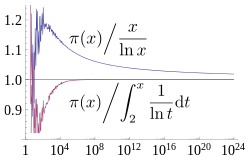Fitxer:Prime number theorem ratio convergence.svg

Mida d'aquesta previsualització PNG del fitxer SVG: 250 × 160 píxels. Altres resolucions: 320 × 205 píxels | 640 × 410 píxels | 1.024 × 655 píxels | 1.280 × 819 píxels | 2.560 × 1.638 píxels.
Fitxer original (fitxer SVG, nominalment 250 × 160 píxels, mida del fitxer: 87 Ko)
Historial del fitxer
Cliqueu una data/hora per veure el fitxer tal com era aleshores.
| Data/hora | Miniatura | Dimensions | Usuari/a | Comentari | |
|---|---|---|---|---|---|
| actual | 15:07, 21 març 2013 |  | 250 × 160 (87 Ko) | Dcoetzee | Change n to x to match article |
| 14:30, 21 març 2013 |  | 250 × 160 (86 Ko) | Dcoetzee | Convert formula from graphics to pure SVG using http://www.tlhiv.org/ltxpreview/ | |
| 14:23, 21 març 2013 |  | 250 × 160 (130 Ko) | Dcoetzee | {{Information |Description ={{en|1=A plot showing how two estimates described by the prime number theorem, <math>\frac{n}{\ln n}</math> and <math>\int_2^n \frac{1}{\ln t} \mathrm{d}t = Li(n) = li(n) - li(2)</math> converge asymptotically towards <ma... |
Ús del fitxer
La pàgina següent utilitza aquest fitxer:
Ús global del fitxer
Utilització d'aquest fitxer en altres wikis:
- Utilització a ar.wikipedia.org
- Utilització a bn.wikipedia.org
- Utilització a el.wikipedia.org
- Utilització a en.wikipedia.org
- Utilització a fa.wikipedia.org
- Utilització a he.wikipedia.org
- Utilització a hu.wikipedia.org
- Utilització a hy.wikipedia.org
- Utilització a id.wikipedia.org
- Utilització a ja.wikipedia.org
- Utilització a no.wikipedia.org
- Utilització a pl.wikipedia.org
- Utilització a sl.wikipedia.org
- Utilització a sr.wikipedia.org
- Utilització a sv.wikipedia.org
- Utilització a ta.wikipedia.org
- Utilització a vi.wikipedia.org





